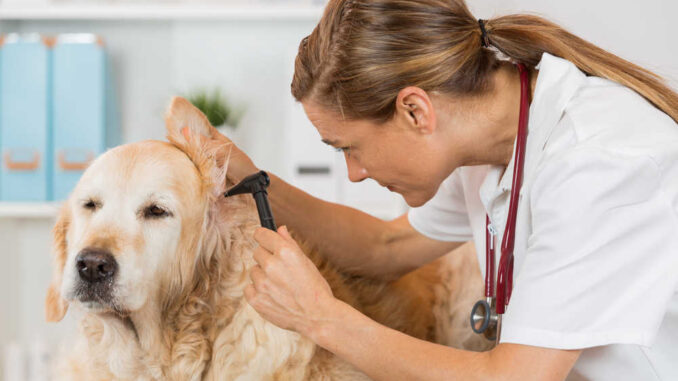
This article was updated on January 15th, 2024

Yeast ear infections are a common health condition in our canine companions, often causing:
- intense ear scratching,
- black or brown ear discharge,
- redness and swelling, and
- a strong, musty yeast smell that follows your dog wherever he goes.
In this article, we will review pictures of yeast infections, describe what yeast infections look like in dogs, and offer practical tips to help your dog.
‘Normal ear’ versus ‘ear with a yeast infection’
You may not remember the ear’s appearance before the itching and headshaking started. Here is a picture of a healthy ear – no redness or discharge. This picture shows how a clean, non-infected dog ear should look:
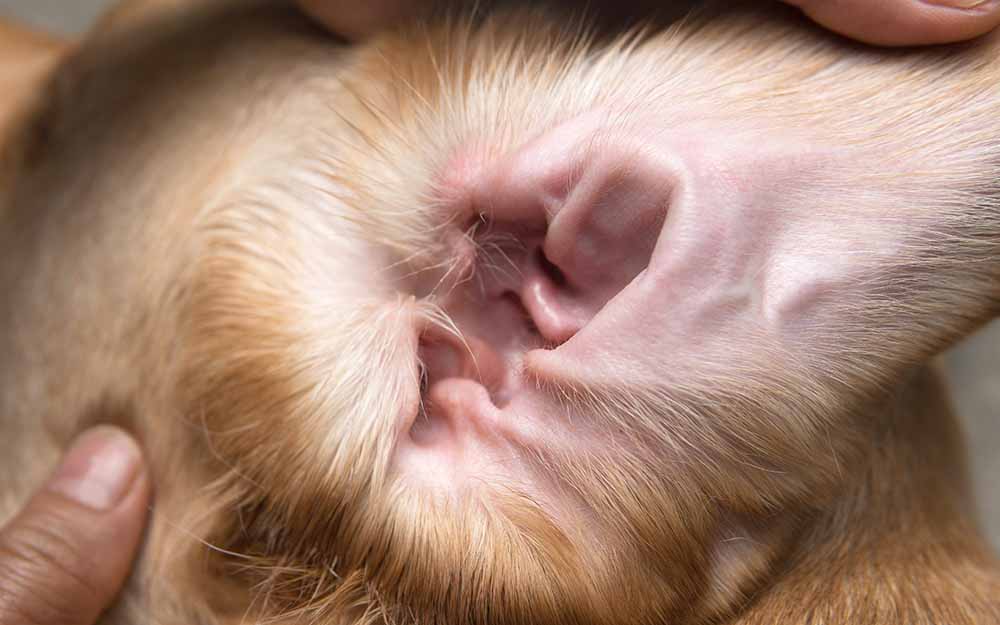
The pictures below shows the dog’s ear canal with heavy dark brown wax buildup commonly seen in yeast ear infections. The ear wax color can range from yellow to blackish-brown.
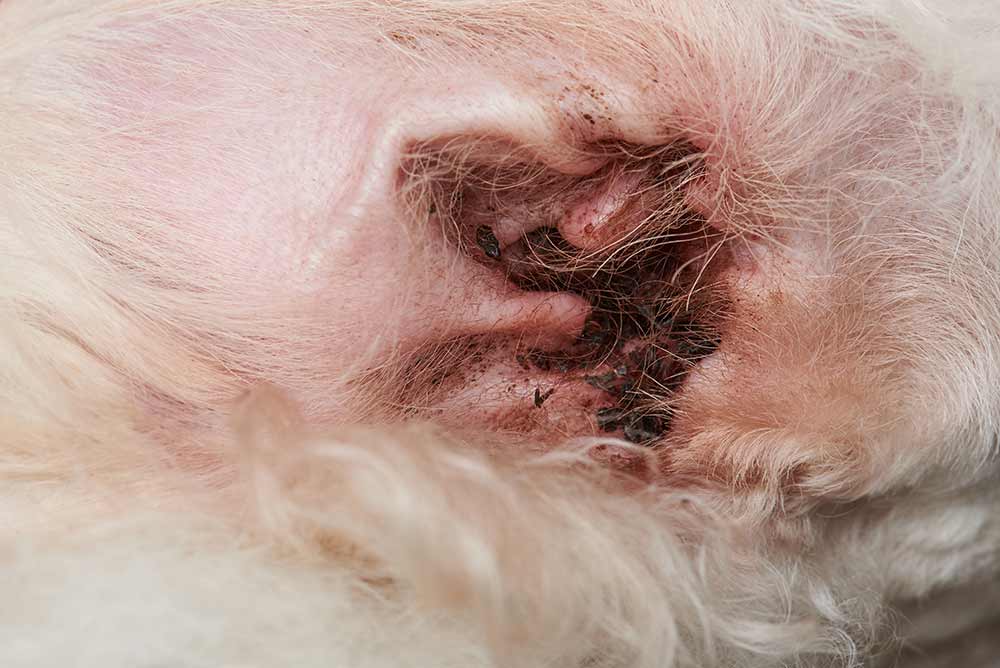
Yeast overgrowth in the ear canal causes irritation and inflammation, as shown in the picture below:
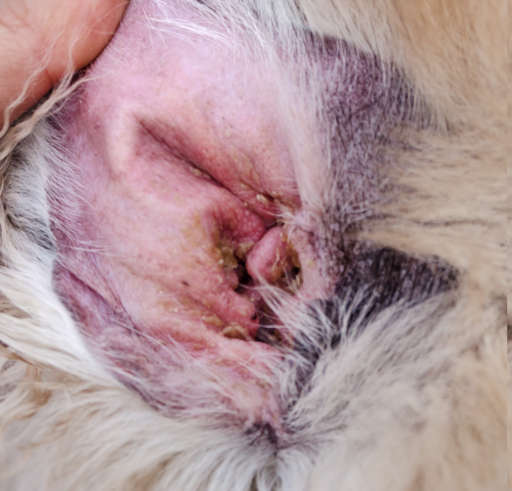
What you can’t see that commonly accompanies a yeast ear infection is a musty, cheesy odor. Let’s now look at pictures of the key symptoms of yeast ear infections.
6 Symptoms of Dog Ear Yeast Infections [With Pictures]
1. Excessive ear scratching: This is often one of the first symptoms owners notice at home. Occasional ear scratching is normal, but if it happens so frequently that it interrupts your dog’s daily activities or that is all your dog can focus on, he may have an infection.

2. Headshaking: Some dogs with ear infections will also shake their heads constantly. This is often due to discomfort.

3. Red, inflamed skin: The inside of a healthy dog’s ear should be a nice pale pink with no apparent scratches or redness. An infected ear is inflamed, meaning it may be splotchy and brighter pink or red.
The picture below shows the inside of the dog’s ear, which is redder than normal. This is common in the early stages of ear infections; your dog may or may not have the black or brown ear discharge at this point as well. Note that there is not much visible discharge in this ear, although there may be farther down in the ear canal:
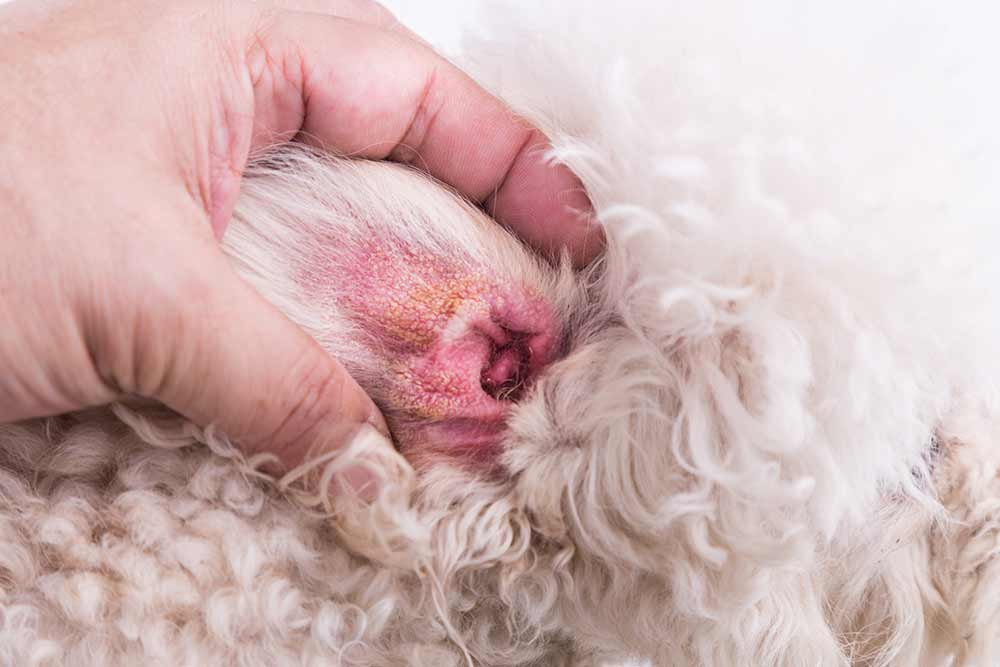
If you aren’t sure if your dog’s ear is redder than normal, compare the itchy ear to the normal one. One may be redder than the other. This comparison only works, though, if only one ear is infected. It is common for your dog to have yeast infections in both ears, but one may be worse.
4. Discharge: One of the most characteristic features of a yeast ear infection is the heavy black or brown ear discharge in the ear canal. Owners often describe it as looking like dirt from the garden. Most dogs should have little to no ear wax visible in a healthy ear, although some yellow wax is considered normal. As shown in the picture below, mild to moderate brown discharge and redness inside the ear are common with yeast infections:
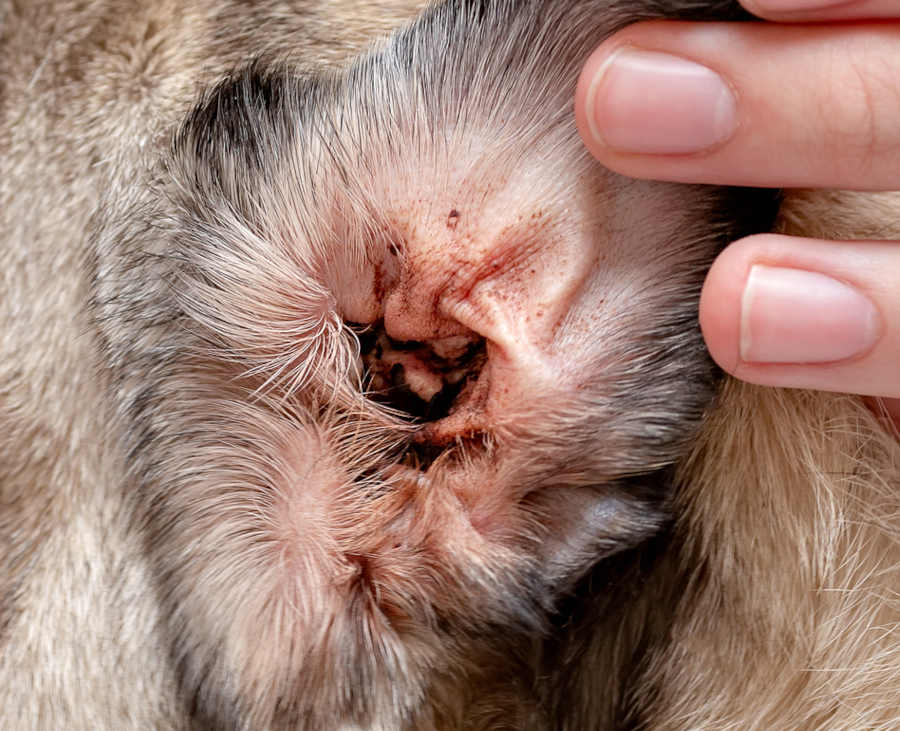
5. Unpleasant smell: While not a visual characteristic of an ear infection in dogs, yeast infections tend to have a strong smell that many describe as cheesy or musty.
6. Head tilt: Some dogs will have a temporary head tilt when they have an ear infection.

Hematomas: a less common but important symptom of an ear infection – Some dogs with severe or chronic ear infections can develop hematomas in the ear flap. This buildup of blood between the skin and cartilage is caused by a broken blood vessel inside the ear flap. Some dogs will get hematomas due to excessive headshaking or scratching. The picture below shows a hematoma, a blood buildup between the layers of the ear. It often feels like a squishy balloon in the ear:
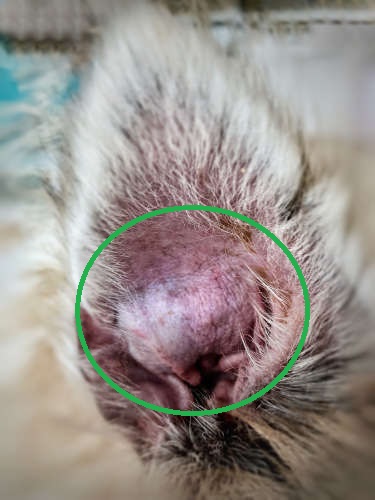
Three steps you can take at home to help your dog with a yeast ear infection
While ear infections are typically not an emergency, it is hard to watch your pup scratch uncomfortably. You can do a few things at home until you can see your veterinarian.
1. Put a cone on your dog
We know this is not your or your dog’s favorite thing, but it does help break the cycle of itch and trauma to the surrounding skin. This is especially important in preventing ear hematomas too.
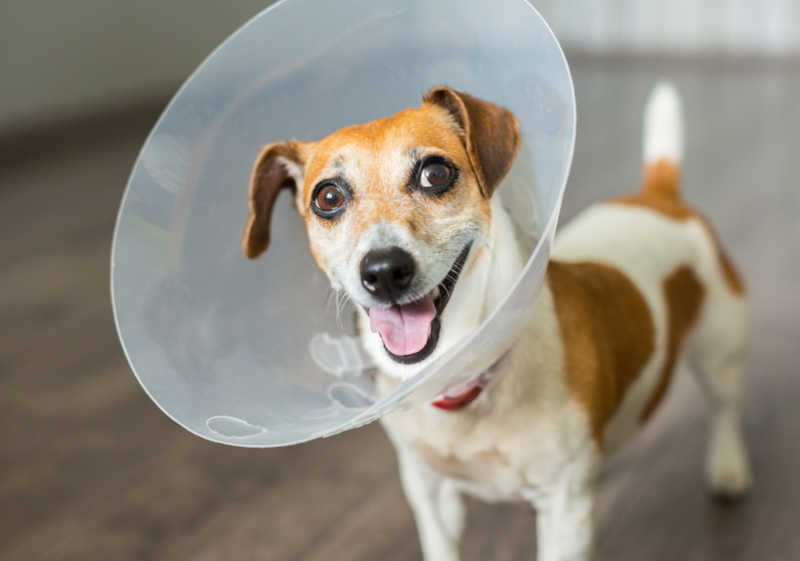
2. Use cold compresses for temporary pain relief
You hold a frozen bag of veggies wrapped in a dry towel over the affected ear. If your dog is too uncomfortable with this, don’t force it.
3. Gently clean the ears
Use a gentle ear cleaner recommended by your veterinarian to clean your dog’s ears regularly. This will help to remove excess wax and debris, and prevent yeast from growing. View our recommendations for dog ear cleaners.
4. Dry the ears
After cleaning your dog’s ears, use a clean, dry cloth or cotton ball to dry the ears thoroughly. Moisture can contribute to the growth of yeast, so keeping your dog’s ears dry is important.
Key tip: DO NOT use Q-tips in your dog’s ears. These can push wax further into the ear, break inside the ear canal, and cause problems. Remember to always be gentle when caring for your dog’s ears, and never insert anything into the ear canal. You should also seek veterinary care as soon as possible because ear infections can be very painful for your dog and worsen over time if not treated correctly.
Is it a yeast infection, or is it something else?
Several other medical conditions can look like yeast ear infections. These include:
- Bacterial infections: While many ear infections in dogs are caused by yeast, it is possible to have bacterial or even mixed infections with both yeast and bacteria.
- Ear mites: Although less common in dogs than in cats, ear mites can cause similar symptoms to those seen with yeast ear infections. There is often heavy brown discharge, redness, and discomfort. Find out how to tell the difference between ear mites and yeast infection with our article: Is it a yeast infection or ear mites?
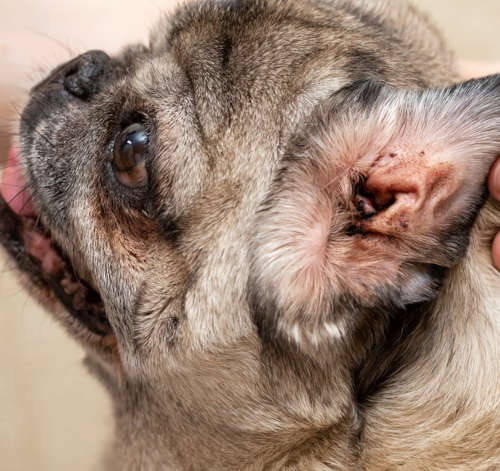
- Foreign body in the ear. The following picture shows a foxtail weed stuck in a dog’s foot. These can also occasionally get into a dog’s ear and cause intense discomfort, even embedding into the ear canal and causing infection:
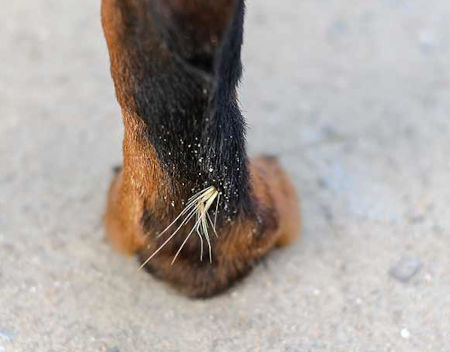
When to call the veterinarian
A few signs your dog is giving you may indicate it’s time to see the vet.
- Worsening redness, smell, or discharge: If the ear is getting redder, smells worse, or has a lot of brown discharge, it is likely infected and needs treatment.
- Constant itching: Your dog is constantly itching or yelping when scratching their ears.
- Sensitivity to touch: If your dog shows signs of pain or sensitivity when you touch their ear, it may be a sign of infection.
- Changes in behavior: If your dog is lethargic or irritable, it may be a sign that they are not feeling well, and veterinarian help is needed.
It is important to seek veterinary care when your dog has an ear infection because ear infections can be quite uncomfortable and painful for your dog, and they can lead to more serious health problems if left untreated.
Treating an ear infection can be complex, and it’s important to use the right treatment for the underlying cause of the infection. Your veterinarian can prescribe medications, such as antibiotics, antifungal drugs, or steroids, to help treat your dog’s infection. They can also recommend other treatments, such as ear drops, ear cleaning solutions, or dietary changes, to help manage your dog’s symptoms and prevent future infections.
Veterinary treatment, costs & recovery
While your vet may suspect an ear infection based on their physical exam and your dog’s symptoms, they will likely still want to do some testing. The vet uses an otoscope to visualize the ear canal and eardrum during an ear exam. This also helps them see if there is a foreign body, like a grass seed stuck in the ear.
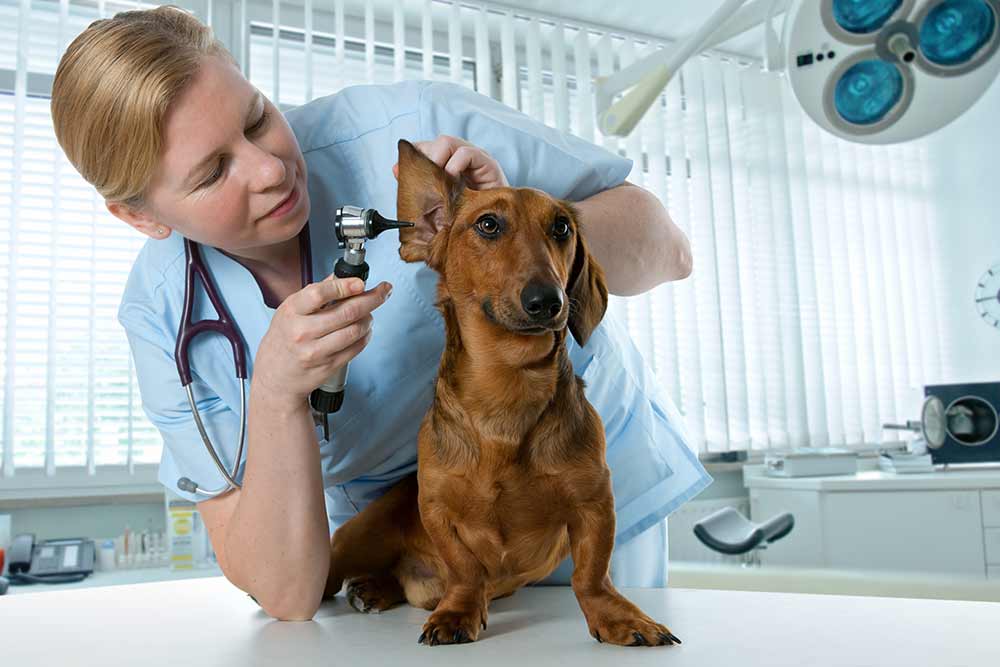
In uncomplicated or first ear infections, testing usually involves an ear swab. A cotton swab is gently put inside the ear to get a sample of the waxy discharge. This sample is then rolled out on a microscope slide, stained with a special dye, and viewed under a microscope. Your vet is looking for various bacteria, yeast, and even mites. This test helps your vet pick the most appropriate medication for your dog’s infection.
If your dog has a yeast ear infection, your vet must prescribe an ear drop or cleaner with anti-fungal properties. The following image shows how the cotton swab may look when the vet takes a sample from an infected ear/yeast infection in the ear. This is a build-up of wax, skin cells, and microscopic yeast and bacteria:

How much will it cost to treat a yeast ear infection? The average cost of treating an ear infection is around $320-$375, although it will vary based on your location and the severity of the yeast ear infection. Costs will include:
- Office visit and diagnostic tests like an ear swab
- Ear cleaning and medication administration
- Ear medications and cleaners
Recovery
Most dogs will recover from an uncomplicated yeast infection in the ear within two weeks. It may take longer if your dog also has bacteria in the infection, which can sometimes be resistant to antibacterial ear drops. Remember to follow all your vet’s instructions: keep the cone on and administer ear cleaning solutions and medication as directed.
How to prevent ear infections
While it isn’t possible to completely prevent ear infections, there are steps you can take at home to help your dog’s ears stay healthy.
1. Routine ear cleaning: Maintaining healthy ears involves regular ear cleanings. The frequency you need to clean may depend on your dog’s lifestyle. If you have a lab or dog with long floppy ears, you may need to clean them every few weeks, as these dogs are more prone to ear infections. It is also a good idea to do a quick clean if your dog has been swimming.
Make sure you are using a NON-MEDICATED cleaner unless directed by your veterinarian for these routine cleanings. Do NOT use apple cider vinegar or peroxide, as these can harm the sensitive skin inside the ear.
2. Control allergies: If your dog is prone to skin issues like allergies, they are also more prone to ear infections. The ear is just a continuation of the rest of your dog’s skin! If your dog has an allergy flare – itchy, red skin, licking paws, etc. – speak to your vet about medications to help. This will help keep your dog’s skin healthy and decrease the likelihood of ear infections. Learn more about ear infections from allergies.
Breeds more at risk: Unfortunately, some breeds are predisposed to ear infections. These breeds include labs, Golden retrievers, Spaniels, Basset hounds, and pit bulls. If you have one of these breeds, you may have to work a bit harder to prevent ear infections. Work with your vet on a plan for good ear health and maintenance.
Related posts:
Disclaimer: This website's content is not a substitute for veterinary care. Always consult with your veterinarian for healthcare decisions. Read More.








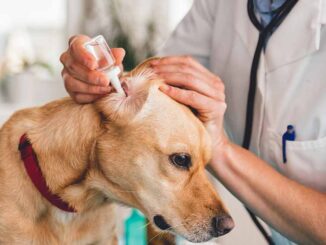
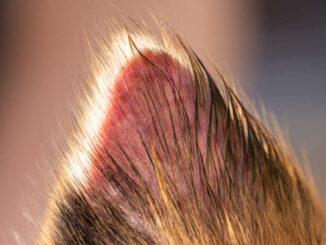
Be the first to comment